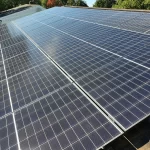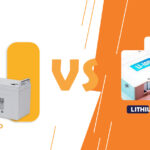Last Updated on November 1, 2023 by admin
When looking for solar panels for your photovoltaic (PV) system, you’ll come across two basic choices: polycrystalline vs. Monocrystalline solar panels. Both types of panels use sunlight to generate electricity, but there are several crucial distinctions to be aware of.
Check out the Estimated Solar Cost of your home INSTANTLY!
Its 100% FREE
You can have a quick idea about the cost of switching to solar
Our Energy professionals are one call away for advice
Important Points To Remember
- The performance of your solar energy system, energy output, and payback period are all impacted by the type of solar panels you install.
- Monocrystalline solar panels are more efficient and function better in high temperatures.
- Polycrystalline panels are more affordable, they are less efficient and take up more roof space.
- Monocrystalline solar panels are usually considered the most effective and efficient type of solar panel due to better solar panel efficiency ratings and overall capacity to produce more solar power per square foot.
- if you want to save some money upfront or like panels with a blueish tinge, polycrystalline solar panels are an outstanding option.
What's in this Article?
- What are Monocrystalline and Polycrystalline Solar Panels?
- How to compare Polycrystalline vs. Monocrystalline Solar Panels?
- Polycrystalline vs. Monocrystalline Solar Panels: What are the Pros & Cons?
- Polycrystalline vs. Monocrystalline Solar Panels: How to Choose the Best Solar Panels for Your Home?
- Polycrystalline vs. Monocrystalline Solar Panels: Which Type of Solar Panels Are Right for You?
To increase the effectiveness of panels, solar manufacturers are continually exploring new solar technology. As a result, the manufacturing of solar cells has diversified into several different cell technologies.
Your system’s overall performance and potential for cost savings are determined by the type of solar panels you select. Top solar companies provide a variety of panels, although monocrystalline and polycrystalline are the most common. They both complement home solar systems effectively, but they differ in terms of efficiency, aesthetics, and long-term advantages.
We will examine the pros & cons of polycrystalline VS monocrystalline solar panels for you in this article. Also, we will highlight what type of panels is suitable for your home.
What are Monocrystalline and Polycrystalline Solar Panels?
The two most common types of solar panels for homes are monocrystalline and polycrystalline PV panels. One of the most widely used materials on Earth is silicon, a chemical element that is used to make these materials. Due to its semiconductor characteristics, it is an ideal material for solar cell technologies as it helps in absorbing sunlight for power conversion. PV cells transform solar energy into useful power after absorbing it. Crystalline silicon cells use in both monocrystalline (mono) and polycrystalline (poly) panels. However, each type of panel requires a different manufacturing process for these cells.
Monocrystalline Solar Panels
The “mono” in monocrystalline refers to the manufacturing technique of using a single silicon crystal. An ingot is created by shaping the crystal into a cylinder-like shape in a laboratory. To fit more silicon ingots into a panel, solar panel manufacturers slice silicon ingots into thin discs or silicon wafers. After that, the solar cells made from these wafers are assembled and put into the panel modules.
Single crystal solar panels have a higher efficiency than other solar panels, which improves the power output for your home. However, monocrystalline panels are more expensive since the production process is more costly. Additionally, a surplus of wasted silicon material that cannot be used for mono panels is produced during the process.
Polycrystalline Solar Panels
Polycrystalline solar cells consist of several fragmented silicon crystals, often including excess silicon from the mono-panel manufacturing process. These pieces of silicon are melted and fused to produce polycrystalline solar cells, which are then sliced into thin cubes.
Although silicon fragments may have surface imperfections that can lower their efficiency, their production as silicon wafers is relatively easier and more cost-effective. Additionally, the reuse of leftover crystals from the production of monocrystalline panels can help to lower the cost of silicon materials. Consequently, polycrystalline solar panels tend to be more affordable.
How to Compare Polycrystalline vs. Monocrystalline Solar Panels?
The differences between polycrystalline vs. monocrystalline solar panels include total cost, design, and efficiency. Let’s compare both types of panels for better understanding.
1-Average Cost
The cost of solar panels particularly depends on the manufacturing process. In the case of polycrystalline vs. monocrystalline solar, monocrystalline panels are complex and involve higher-quality materials. Low-quality silicon cells, some of which are recycled from the monocrystalline production process, are used for making polycrystalline panels. Lower costs result from these cost savings. The price of additional solar panel installation components like inverters and wiring is the same for both panel types.
The type of solar panel you select can have an impact on your solar payback period, typically ranging from six to ten years. Opting for more efficient monocrystalline panels can result in greater energy conversion. This leads to higher solar power generation for your home. Compared to expensive fossil fuels, solar energy is more cost-effective, resulting in a shorter payback period. However, selecting polycrystalline panels may not result in the same long-term savings, and therefore, may not shorten your payback period.
2- Efficiency Rating
While comparing polycrystalline vs. monocrystalline solar panels, one significant contrast is their solar efficiency rating. The efficiency rating indicates the percentage of sunlight a solar panel can absorb and transform into electricity. For instance, if a solar panel has a 15% efficiency rating, it can convert 15% of the sunlight it receives into usable electricity. On average, polycrystalline panels have an efficiency rating of 13% to 16%, while monocrystalline panels have a higher range of 15% to 23% efficiency.
Typically, monocrystalline solar panels are more efficient than polycrystalline solar panels. This is because monocrystalline panels consist of a single crystal of silicon which enables the unimpeded flow of electricity throughout the panel.
3-Solar Panel Design
Regarding the looks of solar panels, many homeowners have particular preferences. Monocrystalline panels can be a better choice if maintaining your home’s attractiveness is vital to you. These panels are black and complement the majority of roof styles well. However, due to their blue color, polycrystalline panels stand out more on rooftop solar installs.
4-Roof Space
When deciding between polycrystalline vs. monocrystalline solar panels, roof space is yet another important consideration. Mono solar panels convert sunlight more quickly because they are more effective. As a result, homeowners may effectively power their homes with fewer monocrystalline panels. These panels are best fit for homes with limited roof space.
On the other hand, poly solar panels function oppositely. You’ll want more panels to supply your home with the energy it needs because of their lower efficiency rating. To fit these extra panels, your roof must have sufficient space.
5-The lifespan of Polycrystalline vs. Monocrystalline Solar Panels
The average lifespan of crystalline solar panels is 25 years. This is compatible with the standard solar panel warranty period. With routine solar maintenance, your panels will last longer than the manufacturer’s 25-year warranty. While monocrystalline panels can last up to 40 years, polycrystalline panels have a lifespan of 25 to 35 years.
Despite having a long lifespan, panels gradually lose efficiency. Solar panels degrade on average about 0.5% annually, according to the National Renewable Energy Laboratory for the U.S. Department of Energy. This is the reduction in watts and power output. Because high-efficiency panels are more powerful and efficient, a degradation drop doesn’t have as much of an effect. Lower-efficiency panels may experience considerable effects from a decline in performance.
6-Temperature Coefficient
The performance of solar panels is tested by manufacturers under Standard Test Conditions (STC) at 77 degrees Fahrenheit. Between 59 and 95 degrees Fahrenheit, the panels continue to operate at their best efficiency; anything outside of this range results in a reduction in efficiency.
The temperature coefficient of a panel indicates how much power output will reduce when subjected to high temperatures. The poorer a panel performs in bad weather, the higher the temperature coefficient. Monocrystalline panels perform well in high temperatures and have a low-temperature coefficient. Due to their greater temperature coefficient, polycrystalline panels often perform less in hotter regions.
Add Your Heading Text HePolycrystalline vs. Monocrystalline Solar Panels: What are the Pros & Cons?

Polycrystalline vs. Monocrystalline Solar Panels: How to Choose the Best Solar Panels for Your Home?
One of the primary reasons to go solar is to save money, and whether you select mono or poly solar panels, you’ll lower your electricity costs. The choice you make will depend on your personal preferences, your available space, and your financing options.
Personal Choices
Remember that monocrystalline and polycrystalline solar panels usually look different on your roof if the color of your solar panels matters to you. While the usual polycrystalline panel normally comes in a bluer color, a standard mono solar panel usually comes in a darker black.
Furthermore, if the solar installation place is vital to you, make sure you have enough information about the best solar brands that manufactured your mono or poly solar panels.
Spacing Limitations
If the size of your PV system depends upon the roof space, higher-efficiency solar panels are recommended. Therefore, it will be more cost-effective in the long term to invest in more expensive monocrystalline panels that will help you maximize your electricity production. Alternately, lower-efficiency polycrystalline panels may be a more cost-effective choice if you have a large roof space or are installing ground-mounted solar.
Solar Financing
Which type of panel you choose may also depend on how you want to pay for your system. You would, for instance, pay per kilowatt-hour for the electricity generated by the system if you choose a power purchase agreement (PPA). In other words, your monthly payments will influence your savings more so than any type of equipment you may be offered. High-efficiency monocrystalline solar panels, on the other hand, can cost more if you are purchasing your system, but they can also increase the return on your solar investment.
Polycrystalline vs. Monocrystalline Solar Panels: Which Type of Solar Panels Are Right for You?
Overall, the performance of your solar energy system, energy output, and payback period are all impacted by the type of solar panels you install. Monocrystalline solar panels are more efficient and function better in high temperatures. Also, they require fewer panels to install and have a more subtle design.
On the other hand, although polycrystalline panels are more affordable, they are less efficient and take up more roof space. Moreover, the exterior attractiveness of your home will also impact by its blue color.
Concludingly, Monocrystalline solar panels are usually considered the most effective and efficient type of solar panel due to better solar panel efficiency ratings and overall capacity to produce more solar power per square foot. But if you want to save some money upfront or like panels with a blueish tinge, polycrystalline solar panels are an outstanding option. However, both will ultimately enable you to reduce your electricity bills.






2 thoughts on “Comparing Monocrystalline and Polycrystalline Solar Panels”
Wow that was strange. I just wrote an extremely long comment but after I clicked submit my comment didn’t appear. Grrrr… well I’m not writing all that over again. Anyhow, just wanted to say wonderful blog!
Spot on with this write-up, I really assume this web site needs rather more consideration. I?ll in all probability be once more to read far more, thanks for that info.
Comments are closed.